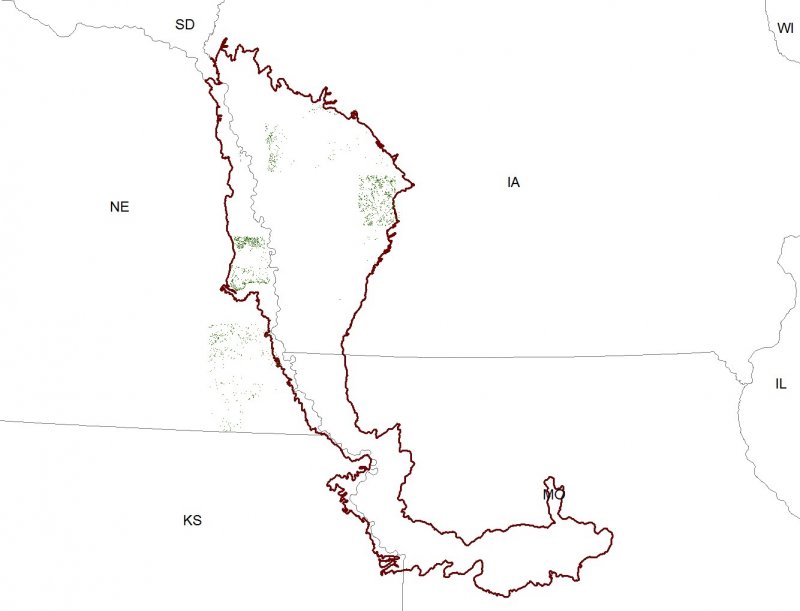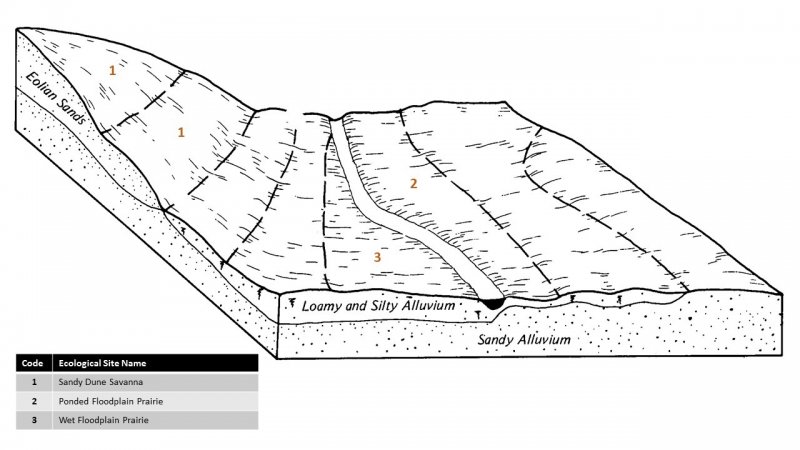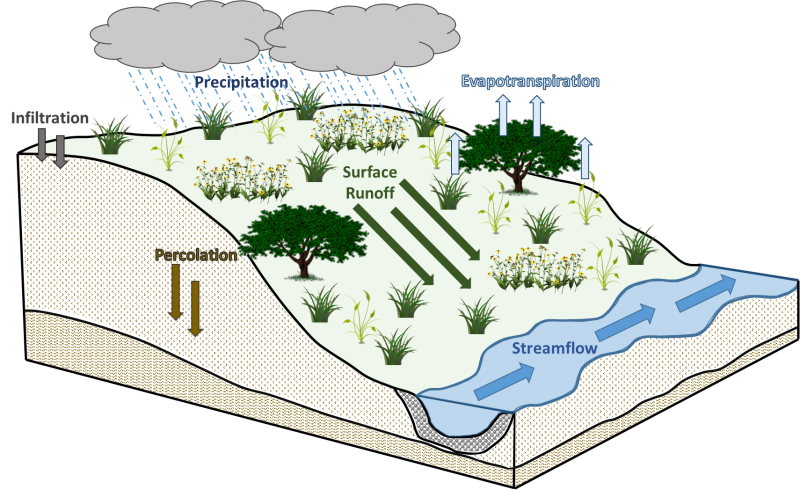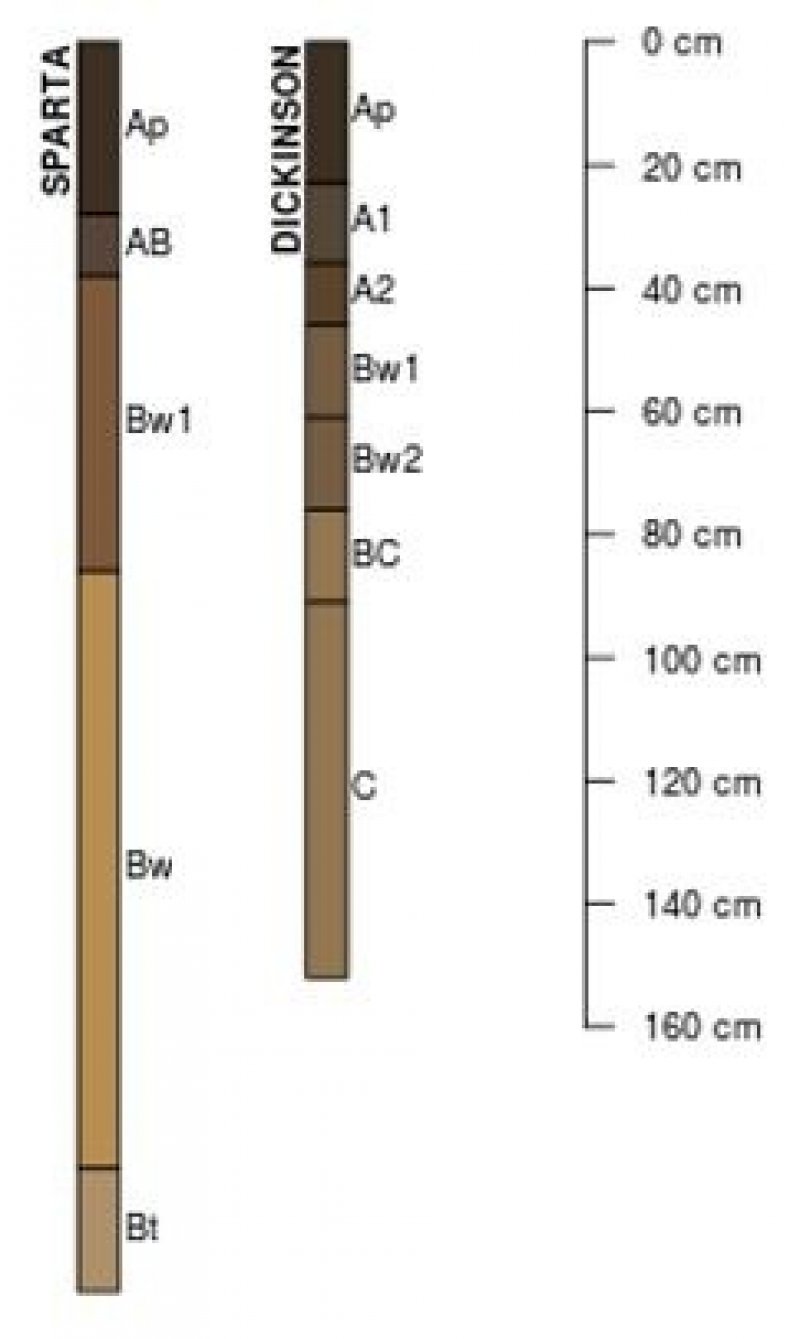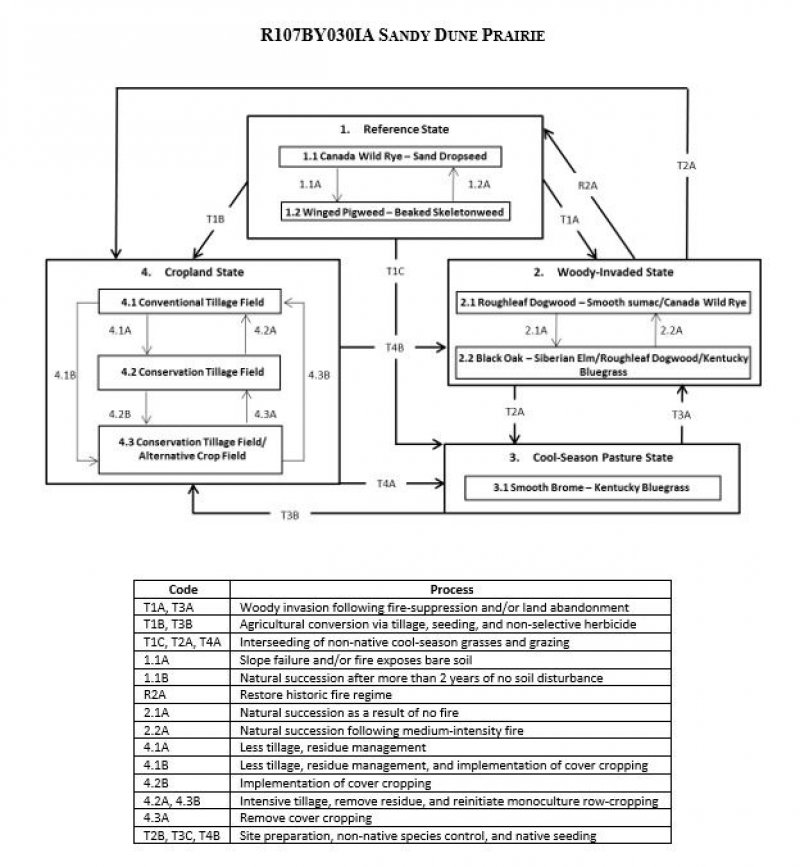
Natural Resources
Conservation Service
Ecological site R107XB030IA
Sandy Dune Prairie
Last updated: 5/21/2020
Accessed: 04/28/2025
General information
Provisional. A provisional ecological site description has undergone quality control and quality assurance review. It contains a working state and transition model and enough information to identify the ecological site.
Figure 1. Mapped extent
Areas shown in blue indicate the maximum mapped extent of this ecological site. Other ecological sites likely occur within the highlighted areas. It is also possible for this ecological site to occur outside of highlighted areas if detailed soil survey has not been completed or recently updated.
MLRA notes
Major Land Resource Area (MLRA): 107X–Iowa and Missouri Deep Loess Hills
The Iowa and Missouri Deep Loess Hills (MLRA 107B) includes the Missouri Alluvial Plain, Loess Hills, Southern Iowa Drift Plain, and Central Dissected Till Plains landform regions (Prior 1991; Nigh and Schroeder 2002). It spans four states (Iowa, 53 percent; Missouri, 32 percent; Nebraska, 12 percent; and Kansas 3 percent), encompassing over 14,000 square miles (Figure 1). The elevation ranges from approximately 1,565 feet above sea level (ASL) on the highest ridges to about 600 feet ASL along the Missouri River near Glasgow in central Missouri. Local relief varies from 10 to 20 feet in the major river floodplains, to 50 to 100 feet in the dissected uplands, and loess bluffs of 200 to 300 feet along the Missouri River. Loess deposits cover most of the area, with deposits reaching a thickness of 65 to 200 feet in the Loess Hills and grading to about 20 feet in the eastern extent of the region. Pre-Illinoian till, deposited more than 500,000 years ago, lies beneath the loess and has experienced extensive erosion and dissection. Pennsylvanian and Cretaceous bedrock – comprised of shale, mudstones, and sandstones – lie beneath the glacial material (USDA-NRCS 2006).
The vegetation in the MLRA has undergone drastic changes over time. Spruce forests dominated the landscape 30,000 to 21,500 years ago. As the last glacial maximum peaked 21,500 to 16,000 years ago, they were replaced with open tundras and parklands. The end of the Pleistocene Epoch saw a warming climate that initially prompted the return of spruce forests, but as the warming continued, spruce trees were replaced by deciduous trees (Baker et al. 1990). Not until approximately 9,000 years ago did the vegetation transition to prairies as climatic conditions continued to warm and subsequently dry. Between 4,000 and 3,000 years ago, oak savannas began intermingling within the prairie landscape. This prairie-oak savanna ecosystem formed the dominant landscapes until the arrival of European settlers (Baker et al. 1992).
Classification relationships
Major Land Resource Area (MLRA): Iowa and Missouri Deep Loess Hills (107B) (USDA-NRCS 2006)
USFS Subregions: Central Dissected Till Plains Section (251C); Loess Hills (251Cb) Subsection (Cleland et al. 2007).
U.S. EPA Level IV Ecoregion: Missouri Alluvial Plain (47d), Steeply Rolling Loess Prairies (47e), Nebraska/Kansas Loess Hills (47h), Western Loess Hills (47m) (USEPA 2013)
Biophysical Setting (LANDFIRE, 2009): Central Tallgrass Prairie (4214210)
Ecological Systems (National Vegetation Classification System, Nature Serve 2015): Central Tallgrass Prairie (CES205.683)
Eilers and Roosa (1994): Sandy Dunes
Nebraska Game and Parks Commission (Steinauer and Rolfsmeier 2010): Missouri River Valley Dune Grassland
Ecological site concept
Sandy Dune Prairies are generally located within the green areas on the map (Figure 1). They occur on hillslopes, ridges, and interfluves. Soils are Entisols, Inceptisols, and Mollisols that are well- to excessively-drained and very deep, formed from glacial or alluvial sediments that have been reworked by wind. Soils are poorly-developed with limited water- and nutrient-holding capability, resulting in a sparsely vegetated plant community.
The historic pre-European settlement vegetation on this site was dominated by a variety of tallgrass prairie species. Canada wild rye (Elymus canadensis L.) and sand dropseed (Sporobolus cryptandrus (Torr.) A. Gray) are the dominant and diagnostic species of this ecological site (Steinauer and Rolfsmeier 2010). Herbaceous species typical of the plant community include cuman ragweed (Ambrosia psilostachya DC.), winged pigweed (Cycloloma atriplicifolium (Spreng.) J.M. Coult.), prairie threeawn (Aristida oligantha Michx.), and slickseed fuzzybean (Strophostyles leiosperma (Torr. & A. Gray) Piper) (Eilers and Roosa 1994; Steinauer and Rolfsmeier 2010). Devil’s-tongue (Opuntia humifusa (Raf.) Raf.) can be a present but uncommon shrub component (Steinauer and Rolfsmeier 2010). Fire and sand blowouts were the primary disturbance factors that maintained this site, while drought and large mammal grazing were secondary factors (Lesica and Cooper 1999).
Relative to other prairie ecological sites in the MLRA, Sandy Dune Prairies have a lower overall species diversity.
Associated sites
| R107XB013MO |
Calcareous Loess Protected Backslope Savanna Calcareous loess soils on upland backslopes including Dow, Hamburg, and Ida |
|---|---|
| R107XB019MO |
Wet Floodplain Prairie Somewhat-poorly to poorly drained clayey soils on floodplains including Ackmore, Aquents, Bremer, Calco, Colo, Cooper, Fluvaquents, Forney, Grantcenter, Holly Springs, Kezan, Lakeport, Larpenteur, Lawson, Mt. Sterling, Nishna, Orthents, Solomon, Tieville, Uturin, Vesser, Wabash, Woodbury, and Zook |
| R107XB008MO |
Loamy Footslope Savanna Colluvium on upland footslopes including Castana, Colo, Danbury, Deloit, Ely, Judson, Napier, Nodaway, Olmitz, Udarents, and Udorthents |
| R107XB027IA |
Calcareous Till Upland Prairie Calcareous till soils including Burchard, Liston, and Steinauer |
| R107XB018MO |
Ponded Floodplain Marsh Ponded soils on floodplains including Aquolls, Darwin, Fluvaquents, Forney, and Levasy |
Similar sites
| R107XB006MO |
Calcareous Loess Exposed Backslope Prairie Calcareous Loess Exposed Backslope Prairies are derived from calcareous loess and have greater species diversity, composition, and cover |
|---|---|
| R107XB012MO |
Calcareous Loess Upland Prairie Calcareous Loess Upland Prairies are derived from calcareous loess and have greater species diversity, composition, and cover |
| R107XB002MO |
Deep Loess Upland Prairie Deep Loess Upland Prairies are derived from leached loess and have greater species diversity, composition, and cover |
| R107XB027IA |
Calcareous Till Upland Prairie Calcareous Till Upland Prairies are derived from glacial till and have greater species diversity, composition, and cover |
Table 1. Dominant plant species
| Tree |
Not specified |
|---|---|
| Shrub |
Not specified |
| Herbaceous |
(1) Elymus canadensis |
Click on box and path labels to scroll to the respective text.
